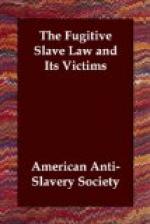Children all born in Pennsylvania; oldest about
seventeen—a girl. Her husband
also in custody, and alleged to be the slave of another
man. Under writ of habeas corpus, Mrs.
Williams was taken before Judge Kane, of the
United States Circuit Court. After a full
hearing, she was discharged, as not being the woman
alleged.
SHADRACH, in Boston, February 15, 1851. Arrested in Taft’s Cornhill Coffee House, by deputies of United States Marshal Devens, on a warrant issued by George T. Curtis, United States Commissioner, on the complaint of John Caphart, attorney of John De Bree, of Norfolk, Va. Seth J. Thomas appeared as counsel for Caphart. After a brief hearing before G.T. Curtis, Commissioner, the case was adjourned to the following Tuesday. Shortly after the adjournment, the court-room was entered by a body of men, who bore away the prisoner, Shadrach. After which he was heard of in Montreal, Canada, having successfully, with the aid of many friends, escaped the snares of all kidnappers, in and out of Boston. The acting President, MILLARD FILLMORE, issued his proclamation, countersigned by DANIEL WEBSTER, Secretary of State, requiring prosecutions to be commenced against all who participated in the rescue.
Shawneetown, Illinois.
A woman was claimed by Mr. Haley,
of Georgia, as his slave;
and was delivered up to him by two
Justices of the Peace,
(early in 1851.)
Madison, Indiana. George W. Mason, of Davies County, Kentucky, arrested a colored man, named MITCHUM, who, with his wife and children, lived near Vernon. The case was tried before a Justice of the Peace, named Basnett, who was satisfied that Mitchum was Davis’s slave, and had left his service nineteen years before. The slave was accordingly delivered up, and was taken to Kentucky, (Feb. 1851.)
Clearfield County,
Penn., about 20th January, 1851. A
boy was kidnapped and
taken into slavery.—Mercer (Pa.)
Presbyterian.
Near Ripley, Ohio.
A fugitive slave, about January 20,
killed his pursuer.
He was afterwards taken and carried back
to slavery.
Burlington, Lawrence County, Ohio, near the end of February, 1851, four liberated slaves were kidnapped, re-enslaved, and sold. Efforts were made to bring the perpetrators of this nefarious act to punishment, and restore the victims to freedom.
At Philadelphia, early in March, 1851, occurred the case of the colored woman HELEN or HANNAH, and her son, a child of tender years. She was taken before a Commissioner, and thence, by writ of habeas corpus, before Judge Kane. An additional question arose from the fact that the woman would soon become the mother of another child. Judge Kane decided that she was the property of John Perdu, of Baltimore, together with her son, and her unborn child, and




